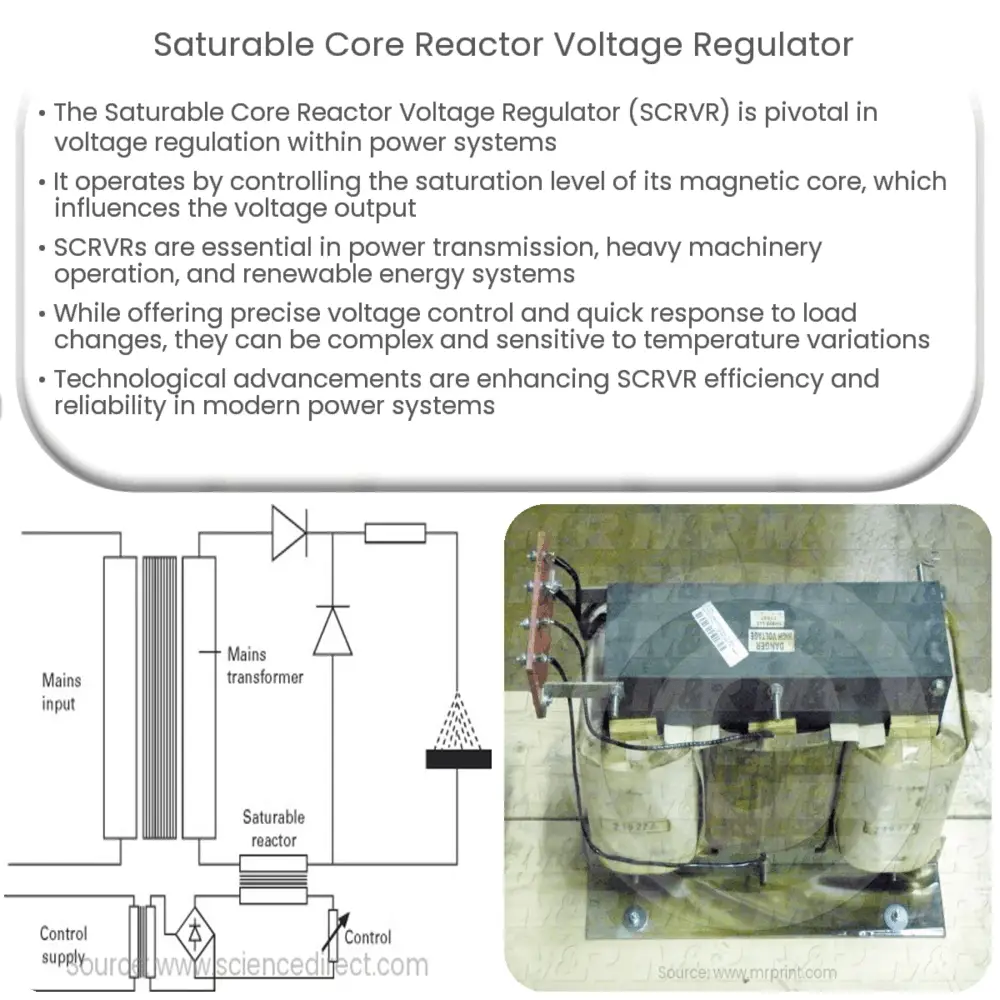Explore the role, working principles, applications, and future of Saturable Core Reactor Voltage Regulators in power systems.

Introduction to Saturable Core Reactor Voltage Regulator
The realm of electrical engineering and power systems is filled with complex devices and principles that allow us to effectively manage and use electrical power. One such principle involves the use of a Saturable Core Reactor Voltage Regulator (SCRVR), a device that plays a crucial role in voltage regulation and stability within power systems.
Understanding the Basic Principles
To comprehend the functioning of a SCRVR, it’s important to have a basic understanding of its fundamental component – the saturable reactor or saturable core reactor. This is a type of magnetic core reactor where the reactance varies with the applied alternating current (AC). The core material is designed to ‘saturate’ or reach its maximum magnetic flux density, upon which its inductance decreases significantly. The core’s saturation level is controlled by a direct current (DC) that is applied via a separate winding, thus modulating the AC inductance and hence, the output voltage.
Role of SCRVR in Power Systems
In the world of power systems, voltage regulation is of paramount importance. Voltage levels need to be maintained within certain limits to ensure efficient operation of electrical equipment. This is where a Saturable Core Reactor Voltage Regulator steps in. By using the principles of a saturable reactor, the SCRVR can effectively control and adjust the output voltage, ensuring stability and mitigating any potential damage to equipment due to voltage fluctuations.
Working Principle of a SCRVR
The working principle of a SCRVR is based on controlling the saturation level of the magnetic core, which in turn influences the voltage level. To do this, a direct current is applied through a separate winding on the core. As the DC increases, it brings the core closer to saturation, thereby reducing its inductance. This impacts the AC circuit, leading to an increase in current and subsequently, a rise in the output voltage.
Applications of SCRVR
Saturable Core Reactor Voltage Regulators find widespread use in a variety of applications. They are commonly used in power transmission and distribution networks, where they help maintain voltage levels within permissible limits. Furthermore, SCRVRs are utilized in industries where precise voltage control is necessary, such as in the operation of heavy electrical machinery, transformers, and power electronics. They also play a pivotal role in renewable energy systems, where voltage regulation is crucial for efficient energy conversion and storage.
Advantages and Limitations of SCRVR
As with any technological device, Saturable Core Reactor Voltage Regulators come with their own set of advantages and limitations. On the positive side, SCRVRs offer a high degree of voltage control precision, which is crucial for the efficient operation of many power systems. They also possess a unique ability to respond quickly to changes in load, thereby ensuring stable power supply even under fluctuating conditions.
However, SCRVRs can be complex and expensive to design and manufacture, particularly for high-voltage applications. Additionally, they require a separate DC source for their operation, which may add to the overall complexity of the system. Furthermore, the saturation characteristics of the magnetic core can be influenced by temperature variations, which may affect the regulator’s performance.
Technological Advancements and Future Outlook
Despite these challenges, recent technological advancements have enabled the development of more efficient and reliable SCRVRs. The advent of advanced materials and digital control systems has significantly improved the performance of these devices, making them an integral part of modern power systems. Furthermore, the increasing emphasis on renewable energy sources and energy efficiency has further stimulated research and development in this area.
Looking ahead, the demand for SCRVRs is expected to continue to grow, driven by the increasing need for reliable and stable power supply in various sectors, including industrial, commercial, and residential. Innovations in materials science and power electronics are likely to lead to even more efficient and versatile SCRVRs, broadening their potential applications and improving their performance.
Conclusion
In conclusion, the Saturable Core Reactor Voltage Regulator is a critical component in the landscape of power systems, playing an essential role in maintaining voltage stability and ensuring the efficient operation of electrical equipment. Despite certain challenges, advancements in technology are constantly improving the performance and reliability of these devices. As our reliance on stable and efficient power systems grows, so too will the importance of SCRVRs in our energy-dependent world.

